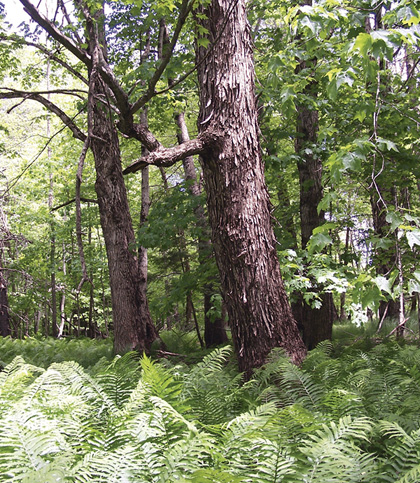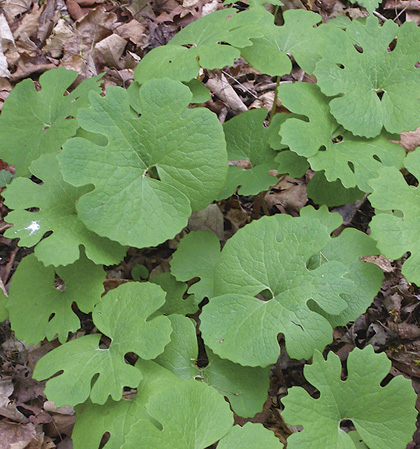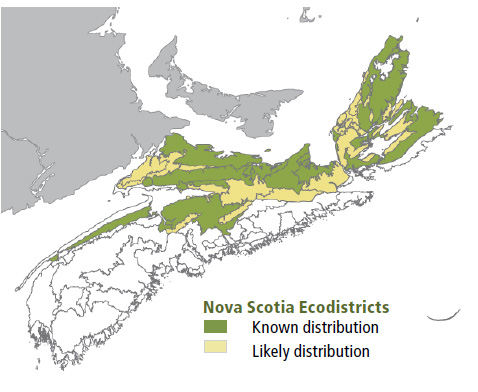
Forest Vegetation types - FP1
FP1 — Sugar maple - White ash /Ostrich fern - Wood goldenrod
Acer saccharum - Fraxinus americana / Matteuccia struthiopteris - Solidago flexicaulis
 |
| Brickton, Annapolis County |
Concept: This late successional forest is characterized by a well-developed canopy of sugar maple and/or white ash. Herbaceous plants usually dominate the species-rich understory, but shrub development can be moderate to high in younger or disturbed stands. The low elevation deciduous forest is the last stage of successional development on most large, well drained floodplains. The majority of stands have been reduced in size by past land-use activities and/or natural river disturbances.
Vegetation: The overstory may feature one or more layers, depending on the age structure and successional history of the stand. Although many occurrences of FP1 originate with floodplain formation, the inherently dynamic nature of riparian forests often results in pockets of either younger or older trees embedded within the main canopy. This closed canopy ecosystem has well developed layers of sugar maple and/or white ash. Other trees species (e.g. ironwood, white spruce, elm, yellow birch, black cherry) may be found in small clumps or sparsely scattered throughout. Elm is also occasionally found, but rarely in a mature age class because of Dutch elm disease. The species-rich understory is typically dominated by a very well-developed herbaceous layer of ostrich fern, sensitive fern, meadow-rue and numerous other species including several rare vascular plants. Shrub cover is variable but usually reduced, except in younger or disturbed stands. This ecosystem supports very low ground lichen and bryophyte cover.
Environmental Setting: FP1 is mainly associated with fresh to fresh-moist, nutrient very rich alluvium soils. This Vegetation Type (VT) is most often found along rivers in central and northern Nova Scotia, but can also be found in parts of western Nova Scotia and Cape Breton. Most occurrences are on level or gently sloping floodplains. Soils are usually deep medium textured and have low coarse fragment content and minimal humus development. Annual or biannual flood cycles are typical. This VT occurs across southeastern New Brunswick but has been extirpated from Prince Edward Island.
Successional Dynamics: This stable mature forest is the last stage of successional development on rich, actively flooded and well drained riparian soils. It can develop from several early to mid-successional VTs including FP3 (Red maple / Sensitive fern - Rough goldenrod), FP4 (Balsam poplar - White spruce / Ostrich fern - Cow-parsnip) or FP5 (Black cherry - Red maple / Rough goldenrod - Jack-in-the-pulpit). On especially rich river deposits, white ash may play a larger role in stand history, acting as a pioneer before sugar maple advances to co-dominate the canopy. Disturbance agents include flood events, ice scour, insects and disease, and various human activities including farming, cottage and trail development and tree harvest.
Ecological Features: This linear ecosystem can be as narrow as a few meters or exceed one hundred meters in width. Most stands have been reduced in size by past land-use activities, but some less disturbed occurrences are also small by nature. It features a closed canopy and a diverse mosaic of microhabitat features. Plant species richness is the highest of any provincial forest ecosystem, and may include numerous rare plants (e.g. Canada lily, blue cohosh, wild leek, thimbleweed, Canada wood-nettle, hairy sedge, blunt-leaved bedstraw, anise-root and Wiegand's wild rye). Riparian forests may provide important nesting or foraging habitat for amphibian, dragonflies, damselflies and vertebrate species. Many bird species are associated with the forest-shoreline interface. Healthy tracts of riparian forests help buffer riparian disturbances such as flooding and ice scour; they regulate water flow and reduce erosion, provide organic matter and nutrients, and contribute to riparian connectivity. Old growth forests of impressive stature may develop.
 |
| Bloodroot |
Distinguishing Features: Evidence of annual flooding should be apparent. Seasonally active channels are common. Herbs are usually extensive and ground lichens and mosses scarce if present at all. Ostrich fern, meadow rue, Jack-in-the-pulpit and nodding trillium are typical floodplain species. Ironwood is usually present.
| Slope Position: | Level9 Other1 |
Surface Stoniness: |
(Non - Slightly)9 (Moderately)1 |
Bedrock Outcrop: |
(Non-rocky)10 |
Elevation Range: |
7 - 149m |
Slope Gradient: |
Level10 |
Aspect: |
None10 |
Exposure: |
Mod. sheltered4 Sheltered4 Moderate1nd1 |
Microtopography: |
Level7 Slightly2 Moderately1 |
Drainage: |
Well5 Moderately well2 Rapid2 Other1 |
Soil Type: |
ST86 ST8-C2 ST91 nd1 |
Parent Material: |
Alluvium10 |
Rooting Depth (cm): |
(30-45)1 (>45)8 nd1 |
Duff Thickness (cm): |
(0-5)6 (6-10)1 nd3 |

